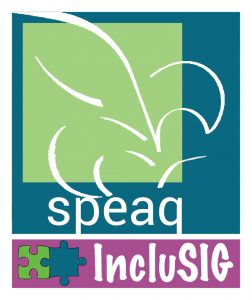Include IncluSIG in Your Inclusive Classroom
(Try saying that 3 times fast!)
An Interview with Michelle Paquette, chair of IncluSIG, SPEAQ’s Special Interest Group to support Inclusive Education.
 Michelle Paquette, IncluSIG chair and more…
Michelle Paquette, IncluSIG chair and more…
Michelle Paquette is the chair of IncluSIG, SPEAQ’s Inclusive Education SIG. She taught ESL to high school students at Vanguard School for 10 years, and is now teaching ESL at École Secondaire Honoré-Mercier in Montreal. I recently met with Michelle to talk about how IncluSIG can help support all ESL teachers in creating a more inclusive classroom. The following is a recap of our very interesting discussion!
Who is included in Inclusive Education?
Inclusive Education is for…. everyone.
Inclusive Education is not only about students with special needs. It is an approach that recognizes the diversity amongst students, as well as their different learning styles. It considers the leaner’s home life, culture, educational background, gender identity, emotional state, as well as their learning difficulties. Each student starts at a different place and has different needs-even if they have a similar diagnosis. Rather than being a one-size-fits-all approach, it is a flexible and responsive practice that removes barriers to help ensure the success of all students. This is not an easy task! That is why we have groups like IncluSIG to help teachers make it a reality!
What are IncluSIG’s objectives?
- To support ESL teachers in playing a significant role in their students’ success.
IncluSIG will offer realistic ways for ESL teachers to become more involved with their students’ success. - To help clarify concepts.
IncluSIG will help make concepts like Differentiation and Growth Mindset more accessible to ESL teachers. - To demonstrate how to efficiently use resources in your inclusive classroom.
IncluSIG will demonstrate how to use familiar materials and quickly and effectively adapt them for different needs.
What are the top 4 things to recognize about the Inclusive Classroom?
- Recognize that every classroom is an inclusive classroom.
No classroom is homogenous. Each student brings with them their own identity which consists of differences in home life, socio-economic status, culture, parent support, gender identity, emotional state, as well as diagnosis. - Recognize that what you teach may or may not have an immediate impact.
Students will all be affected, but not always in the way you had planned. - Recognize the importance of making a connection with your students, but that that connection may take longer for some learners than for others.
Again, the connection will come, but not necessarily in the way you planned. - Recognize that you cannot become the perfect inclusive classroom teacher overnight.
Not overnight, in a week, or even in a year. The clientele is always changing and so will your approach.
What are your favourite resources?
Books
♥ Teaching With Purpose, Karen Gazith
♥ What Great Teachers Do Differently: Nineteen Things That Matter Most, Todd Whittaker
Video
♥ Season 1 Episode 6 – Karen Gazith INCLUSIVE EDUCATION
Websites
♥ Let’s Make Teaching Better, Dave Stuart Jr. https://davestuartjr.com/
♥ Cult of Pedagogy https://www.cultofpedagogy.com/
IncluSIG Newsletters
♥ June 2021
♥ March 2021
♥ September 2019
♥ June 2019
♥ May 2019
What are IncluSIG’s goals for 2021-2022?
→ Define Inclusive Education so that it is accessible to all.
→ Continue to publish the IncluSIG Newsletters to help teachers stay connected.
→ Examine Growth Mindset: reframing vocabulary to help students.
→ Present a workshop at SPEAQ (stay tuned!!)
The members of IncluSIG are Jacqueline Mallais, Alexandra Brans, Mona Tavaohi and Michelle Paquette. If you are interested in joining their team, or if you have any questions about the SIG, contact Michelle at mdrpaquette@gmail.com. She will be very happy to hear from you!
